|
|
|
|
| BUSSLEIđIN
The
Tˇrshavn city bus network (the red buses)
Reyir břbussar
|
|
 |
|
|
|
|
|
This is a site of historical
record
and does not contain current
service information, which can be found
at www.torshavn.fo
Hendan sÝan vÝsur gamlar
tÝarŠtlanir og ikki tŠr i
eru galdandi
n˙.
Denne
side viser gamle k°replaner og ikke
de aktuelle tider. |
|
|
40th
ANNIVERSARY 1979 - 2019 BŢBUSSAR ═ 40 ┴R
Situated at the
south-eastern end of the island of Streymoy, Tˇrshavn is the capital
and seat of government of the Faroe
Islands. By
international standards it might be considered a small capital city
with
a population of some
19,000 people -
which is nearly a half of the total population of the islands.
But Tˇrshavn
is
big enough
to have its own network of bus routes, linking the commercial
centre with
the housing developments on the hills around the
town and beyond. The name of the town bus network is Bussleiin
which is
Faroese for
`bus
routes'. The blue country buses
in the
Faroe Islands are operated under the name Bygdaleiir.
Local
bus operation in Tˇrshavn is not an entirely new
phenomenon: 75 years ago, in 1944, Ële Arge (1897-1965, known as
Bil-Ëli having had one of the first cars in the islands) organised a
20-seater bus
running between the town centre, the hospital, Argir, Sundsbr˙nna and
to the tuberculosis sanatorium in Hoydalar (opened in 1908). By 1959
the bus routes had been extended to include a run westwards to
Velbastaur.
|
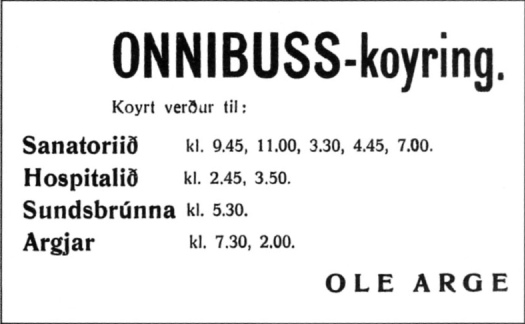
|
1944
timetable for Ole Arge's town bus service around Tˇrshavn and Argir
|
The introduction of town
services in the Faroese capital
in more modern times followed a one day experimental operation which
took place on
Saturday 5
August 1978, using two buses over three routes.
This
was followed by the establishment of regular services from June 1979,
contracted by the town council to local taxi and transport operator p/f
Bil (the word 'bil' simply means car or vehicle). The
half-hourly route pattern of operation required three vehicles, and
these
were Volvo B58 chassis with 29 seat VBK
(Vestfold Bil & Karrosseri) bodies. They carried registrations
F40026, F40027 and F40028.
|
|
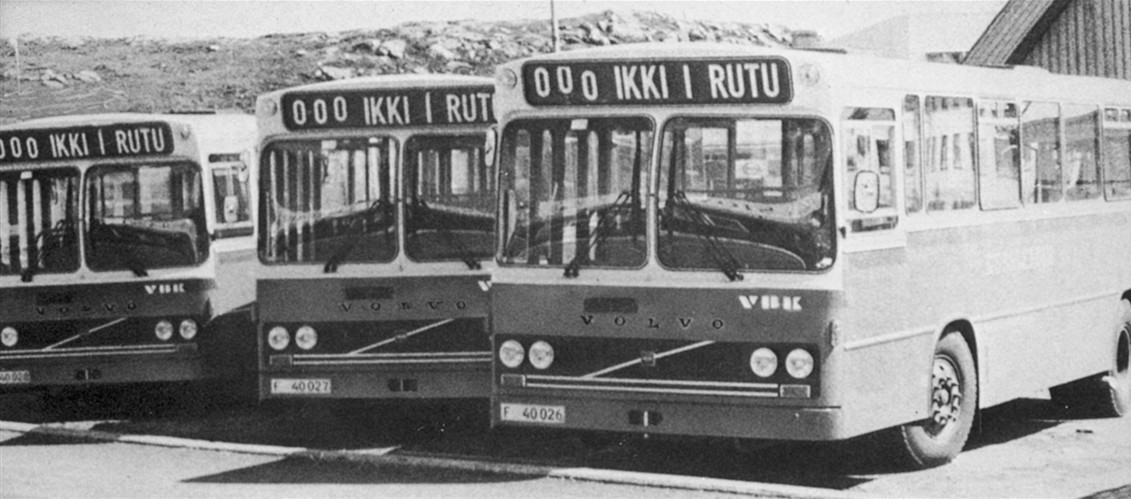
|
The three Volvo buses of p/f Bil
that started the
town service in Tˇrshavn in 1979 (ikki i rutu = not in service)
photo from the Bil
of
Tˇrshavn collection
|
|
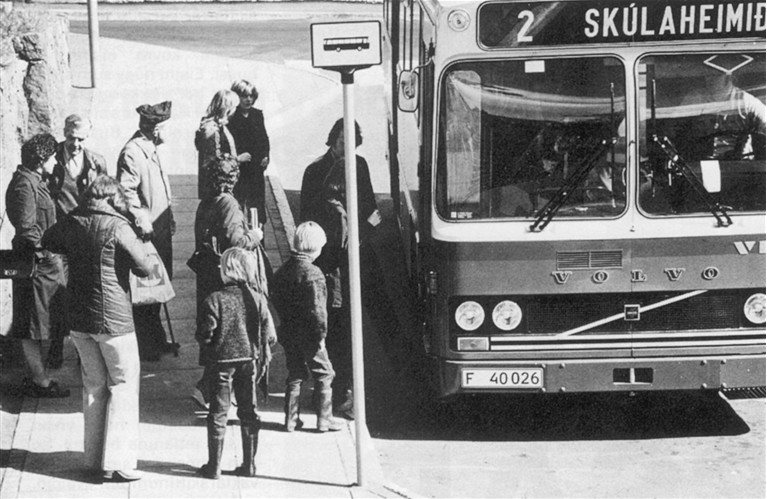
|
Volvo F40026 of p/f Bil on a school run (1979
- 1983)
photo from the Bil
of
Tˇrshavn collection
|
|
|
At that time (1979) there was a
complicated network of six services, as under:
Monday
- Friday daytime and Saturday morning (half hourly) -
1. Hoyvik - R C Effers°esg°ta - Miđbřur (out and back)
2. Miđbřur - Marknagilsvegur - Landavegur - Miđbřur (circular)
3. Miđbřur - Eystursk˙li - Miđstađar°kiđ - Ternuryggur (out and back)
4. Miđbřur - Landavegur - Sj˙krah˙s (hospital) - Miđbřur (circular)
5. Miđbřur - Bursatangi - Miđbřur (circular)
6. Miđbřur - R C Effers°esg°ta - Gundadalur - Varđag°ta - Miđbřur
(circular)
On Monday - Friday evening, Saturday
afternoon and evening, and Sunday all day the routes operated hourly,
excepting the 4 which stayed half hourly. Route 5 changed from its
daytime route at these times, becomingMiđbřur - Eystursk˙li -
Miđstađar°kiđ (out and back, duplicating part of 3).
Miđbřur was the town centre
location now referred to as Steinat˙n.
Service to
Argir
was added in 1980, after that community merged with Tˇrshavn, giving
this pattern of routes:
1. Hoyvik - R
C Effers°esg°ta - Miđbřur (out and back)
2. Miđbřur - Sj˙krah˙s (hospital) - Miđbřur - R C Effers°esg°ta -
Gundadalur - Varđag°ta - Miđbřur - Sj˙krah˙s - Miđbřur (circular)
3. Ternuryggur
- Eystursk˙li - Miđbřur - Sj˙krah˙s - Argir - Sj˙krah˙s - Miđbřur -
Eystursk˙li - Ternuryggur
4. Eysturbřur
- Djˇna Ý Geil G°ta - Miđbřur - Marknagilsvegur - Miđbřur - Djˇna Ý
Geil G°ta - Eysturbřur
Routes 1, 2 and 3 operated
half hourly on Monday to Saturday from 0600 to 2000 and then hourly to
midnight. On Sunday they ran hourly from 0745 to 2345, increased to
half hourly between 1415 and 2015. Route 4 operated half hourly on
Monday to Saturday thoughout the day from 0630 to midnight. On Sunday
the frequency was hourly from 0800 to midnight, incresed to half hourly
between 1430 and 2030. The daytime operation of these four routes
called for five buses. The 'suburban' route to Kaldbak appears in the
timetable for the first time, with four return trips on Monday to
Friday and three on Saturday and Sunday.
Hvitanes was included in
1981 and the northern loop joining
Ternuryggur to Hoyvik and Hvitanes was first operated in 1982 as the
town
grew outwards. Service
reached northwards to Undir Brunni and the Hotel F°royar (the latter
short-lived) in 1983 and also westwards to Norđasta Horn.
The operating contract
changed and from 1983 the buses were
provided on behalf of the Kommuna (town council) by four private
contractors (Mourits Mouritsen, Arne Berg,
Sßmal Blßhamar and Gunleif Danielsen). These were the routes in
1983:
1. Hoyvik - Steinat˙n - Sj˙krah˙s - Steinat˙n - Gundadalur - Varđag°ta
- Steinat˙n - Sj˙krah˙s - Steinat˙n - Hoyvik (subsuming previous route
2)
3.
Hoyvik - Hvitanes - Ternuryggur - Eystursk˙li - Steinat˙n - Sj˙krah˙s -
Argir - Steinat˙n - Eystursk˙li - Ternuryggur - Hvitanes - Hoyvik
4. Hotel F°royar - Undir Brunni - Steinat˙n - Sj˙krah˙s - Norđasta Horn
- Sj˙krah˙s - Steinat˙n - Undir Brunni - Hotel F°royar
Routes 1 and 3 were
half-hourly Monday to Friday daytime and Saturday morning, dropping to
hourly in the evening and all day Sunday. Route 4 was hourly seven days
a week. The adult single fare was 7 krone and the ticket was valid for
one and a half hours.
|
|
| Double
issue Ultimate ticket for single journey 10 krone fare (1998) |
|
Picture taken at
main transfer point Steinatun in central Tˇrshavn in 1992 |
| |
|
|
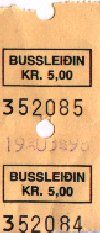 |
|
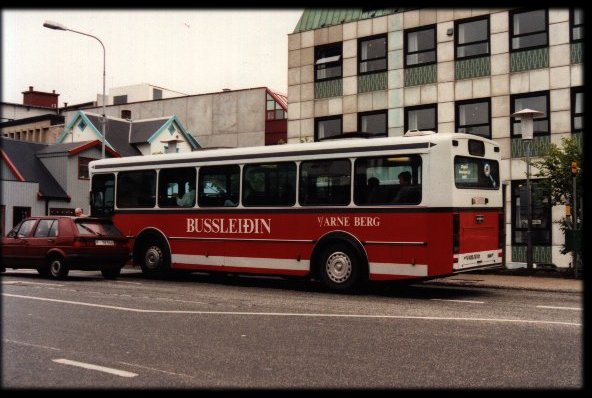 |
|
|
|
The network of routes
seemed a little unsettled and continued with several changes over the
years. In 1991 there were five routes numbered 2 to 6, operating half
hourly Monday to Friday daytime, hourly in the evening and all day
Saturday. There were no longer buses on Sundays. The routes in 1991 are
listed here, and called for seven buses:
2. Norasta Horn -
Marknagilsvegur - Steinat˙n - Hoyvik - Hvitanes - Ternuryggur -
Eystursk˙li - Steinat˙n - Yviri vi Strond - Argir
3. Argir - Sj˙krah˙s
- Steinat˙n - Yviri
vi Strond - Ternuryggur - Hvitanes - Hoyvik - Steinat˙n -
Marknagilsvegur - Norasta Horn
4. Millum Gilja - Undir
Brunni - Steinat˙n - Sj˙krah˙s - Heygsvegur - Sj˙krah˙s
- Steinat˙n (continues as 5)
5. Steinat˙n -
Gundadal - Varag°ta - Sj˙krah˙s
- Heygsvegur - Sj˙krah˙s - Steinat˙n (continues as 6)
(evenings did not serve Sj˙krah˙s loop)
6. Steinat˙n - Undir Brunni -
Millum Gilja
In 1992 Sunday service was
reintroduced on a 90 minute frequency and the town services were
reorganised into the basic pattern of circulars 1, 2 and 3 which would
serve as a foundation for the network of routes into the 21st
century.The four contractors, each with two
Volvo buses, operated the comprehensive red bus network of three main
circular routes.
These served all parts of the town from Argir and Norasta Horn to
Hoyvik and
Hvitanes, with timed connections between routes at Steinatun in the
town centre.
(Steinatun is the central point on J Paturssonarg°ta
on the map
below). The base vehicle
requirement was six buses for the weekday service, and these were
provided on a
four weekly cycle by the four contractors. Second hand buses brought
from Denmark seemed to be favoured at the time. The drivers worked a
basic
five day
week of straight six hour shifts, which seems less than onerous when
compared to
British practice. Adult flat fare was 11 krone in 1992.
Pictured below is the 1995
route map
and list of services. Some 2,700 passenger journeys were made a
day, from
Tˇrshavn's then population of 15,000 people. Daytime
services were still half-hourly, hourly on evenings and all day
Saturday, and every 90 minutes on Sunday (reinstated to hourly in
1997). Route 4 was
then
being operated separately by the
blue Bygdaleiir country buses on behalf of the Kommuna, and it
disappears off the top of the
map to run via Kaldbaksbotnur to the village of Kaldbak, a more distant
part of the
Tˇrshavn community. There were five journeys Monday to Friday, four on
Saturday, three on Sunday. (Farst°in is the ferry terminal for shipping services to the other islands and Sj˙krah˙s is the hospital).
1.
Farst°in - Marknagil - Sj˙krah˙s - Steinat˙n -
Gundadalur - Undir Brunni - Varag°ta
- Sj˙krah˙s - Marknagil - Steinat˙n - Farst°in
2.
Argir - Sj˙krah˙s - Steinat˙n - Yviri
vi Strond - Sundsvegur - Millum Gilja -
Litlagil - Steinat˙n - Landavegur - Norasta Horn
3.
Norasta Horn - Landavegur - Steinat˙n - Hvitanes - Inni ß
G°tu - Sundsvegur - Yviri vi
Strond - Steinat˙n - Sj˙krah˙s - Argir
4.
Tˇrshavn
- Kaldbak (operated by Bygdaleiir as route 104)
|
Hendan
sÝan vÝsur gamlar tÝarŠtlanir og ikki
tŠr i eru galdandi
n˙.
Denne
side viser gamle k°replaner og ikke
de aktuelle tider.
|
|
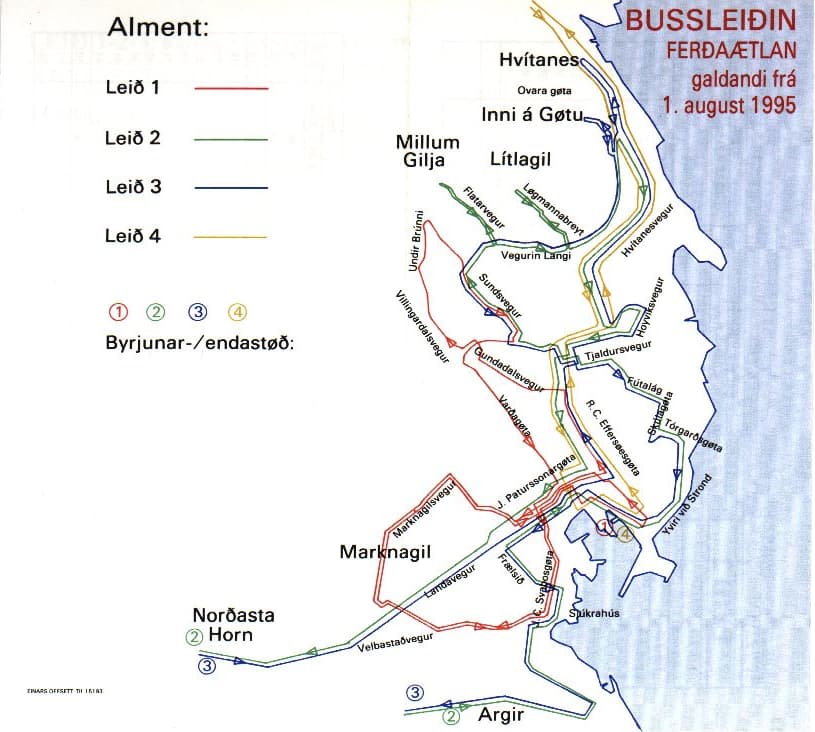
|
|
|
The 1995 pattern of
three half-hourly
circular routes
plus the Kaldbak service continued through the later 1990s until the
Bussleiin
network was enhanced in June 2001 by the addition of new routes 5
and 6. Routes 1 to 4 continued unchanged. Route 5
followed part of
route 4 from the town centre to Kaldbaksbotnur but then proceeded
through the
road tunnel and along the eastern shore to the township of
Kollafj°rur, which by now had also become
also part of the enlarged Tˇrshavn community (and also served along the
same
roads by Bygdaleiir trunk route 400 from Tˇrshavn to Leirvik and
Fuglafj°rur). Route 6 was a new hourly circular service
starting from a
previously unserved southern part of Argir called Hamarin, and
proceeding
through Marknagil, Sundsvegur,
Vegurin Langi, Hvitanesvegur and Yviri vi Strond to the town
centre. It
also linked several of the schools and colleges in the town to
residential
areas. Both routes 4 and 5 had five journeys each Monday to Friday,
four on Saturday, three on Sunday.
These were the 2001 routes:
1.
Farst°in - Marknagil - Sj˙krah˙s - Steinat˙n -
Gundadalur - Undir Brunni - Varag°ta
- Sj˙krah˙s - Marknagil - Steinat˙n - Farst°in
2.
Argir - Sj˙krah˙s - Steinat˙n - Yviri
vi Strond - Sundsvegur - Millum Gilja - Hoyvik - Steinat˙n
- Landavegur - Norasta Horn
3.
Norasta Horn - Landavegur - Steinat˙n - Hoyvik - Hvitanes - Inni ß
G°tu - Sundsvegur - Yviri vi
Strond - Steinat˙n - Sj˙krah˙s - Argir
4.
Farst°in - Kaldbak
5.
Farst°in - Hvitanes - Kollafj°rur
6.
Farst°in - Steinat˙n - Sj˙krah˙s - Hamarin - Marknagilsvegur - Hoyvik
- Sundsvegur - Yviri vi Strond - Farst°in
Further revisions and simplification of the Tˇrshavn bus
network took place in February 2003. Routes 4 and 5 were
combined to operate as route 4 from Tˇrshavn to Kaldbak, returning to
Kaldbaksbotnur and then through the road tunnel to Kollafj°rur.
The town terminus was at Farst°in on the harbour front and near to
both the Bygdaleiir country bus terminus and the off-islands ferries
departure
point. Route
6 was discontinued and town routes 1, 2 and 3 reorganised as
under. The routes are somewhat complicated and circular in
nature. Each then operated
half hourly Monday to Friday daytime, hourly in the evenings and hourly
on Saturday and Sunday - but there was no longer an evening service on
Saturday or Sunday. From 1st February 2003 all buses for routes
1, 2 and 3 were provided by Mouritsens Bussar; since January 2001 buses
for routes 4 and 5 were provided by Gundur Johannesen of
Kollafj°rur. The Mouritsen depot was in Mykinesg°ta (off
Velbastavegur) on the western outskirts of Tˇrshavn.
1.
Hamarin - Sj˙krah˙s - Steinat˙n - Undir Brunni - Varag°ta
- Sj˙krah˙s - Marknagil -
Bursatangi - Steinat˙n - Marknagil - Hamarin
2.
Argir - Sj˙krah˙s - Steinat˙n - Yviri
vi Strond - Hvitanes - Inni ß
G°tu -
Sundsvegur - Steinat˙n - Sj˙krah˙s - Argir
3.
Norasta Horn - Landavegur - Steinat˙n - Sundsvegur - Millum Gilja -
Litlagil - Yviri vi Strond - Steinat˙n -
Landavegur - Norasta Horn
4.
Farst°in
- Kollafj°rur
5.
Farst°in - Kaldbak
With the 2004 timetable routes 4
and 5
were
separated again, at least on Mondays to Fridays, remaining jointly
operated as route 4 on Saturdays and Sundays. Route 1 was slightly
amended in the middle of its circular peregrinations to serve the SMS
shopping centre instead of the short loop that had run to the harbour
front and interurban bus terminal at Bursatangi. In 2006 it was
noted that school special services had
been extended to include Kirkjub°ur
and Velbastaur to the west.
The timetable issued
in January 2007 showed little change to the operating pattern
of
the main services and for the first time full details of the school
services (sk˙lalei
1 to 5) were
included in the timetable booklet. Fares were no
longer charged
permitting free travel for all passengers on all routes at all times as
a deliberate policy to
reduce car use and promote public transport. Tˇrshavn Kommuna
(Municipality)
hopes to create an environment in which the children of the
town consider it perfectly natural that they take the bus,
rather than their parents or friends driving them to and from school,
sports practice or other free-time activities.
The idea was also to investigate if this step could actually influence
the thinking of children regarding travel when they reached the age of
18 and gained the right to drive a car themselves.
From March 2008
the
Monday to Friday daytime timetable for routes 1, 2 and 3 was increased
from half-hourly to a 20 minute frequency. This increased the
base all-day requirement to nine vehicles for the three main routes,
all provided by Mouritsens Bussar. From
August
2009 the town services were reduced in operating hours by
the withdrawal
of Sunday
services and also the cessation of operations at 1400 hours on
Saturday (re-extended to 1600 hours from July 2011).
|
|
|
|
|
|
New Czech built SOR bus in Tˇrshavn July
2011
(as used on routes 1, 2, 3, 5E and 5V)
|
|
Volvo B12 LR260 of Gundurs Bussar used on
the longer route 4
(its 'running mate' on the 4 is Volvo B12 KB638)
|
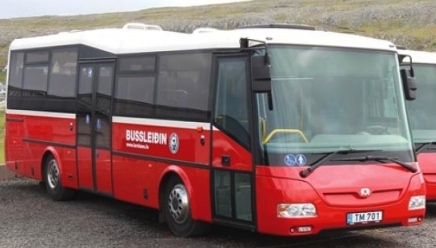 |
|
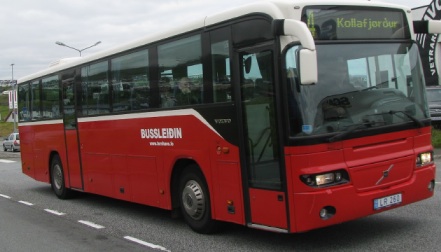
|
| A
retendering exercise for the Bussleiin routes
started in April 2010; this resulted in a 7-year contract being awarded
from 1st April 2011 to a three-way consortium including Jˇn Thomasen of
Kvivik, HZ Bussar of Streymnes and Gundurs Bussar of Signabour. A new
fleet of buses would arrive but initially the vehicles
of previous incumbent operator Mouritsens Bussar were used
temporarily. Eight of the new SOR
buses foreseen in the winning
contract
bid arrived in Tˇrshavn from the Czech Republic on 23rd May, with the
other six soon after.
Following a presentation to the public on 3rd July, the new buses were
introduced into regular service on 4th July 2011 together with an
enhanced timetable which included a new route 5 every two hours running
across central Tˇrshavn from Kaldbak in the east to Velbastaur and
Kirkjub°ur in the west. (Tˇrshavn
municipality had further expanded to include these places). Journeys
running westwards from Kaldbak are operated as route 5V
("vestur") and journeys running east from Kirkjub°ur are operated as route 5E ("eystur").
Further changes to this new timetable were soon introduced from
15th August 2011 with three of the journeys on
5V cut short
to connect with route 2 at Hvitanes and similarly on route 5E with
three of the journeys short running to connect with route 3 at Norasta Horn. In total, there were 17 SOR buses on the
Faroe Islands : the 14 bought new in 2011 (CN 9,5) followed by one
bought used from Denmark in 2013 (CN9,5 and in blue livery not red
until 2019), and lastly two bought used from Denmark in 2019(city version BN 9,5). |
|
|
|
The
Bussleiin routes in operation from August
2011 (all routes run Monday
to Friday daytime and evening; routes 1, 2 and 3 also Saturday daytime):
1.
Hamarin - Sj˙krah˙s - Steinat˙n -
Undir Brunni - Varag°ta
- Sj˙krah˙s - Marknagil - Steinat˙n - SMS - Steinat˙n - Marknagil -
Hamarin
2.
Argir - Sj˙krah˙s - Steinat˙n - Yviri
vi Strond - Hvitanes - Inni ß
G°tu -
Sundsvegur - Steinat˙n
- Sj˙krah˙s - Argir
3.
Norasta Horn - Landavegur - Steinat˙n
- Sundsvegur - Millum Gilja -
Litlagil - Yviri vi Strond - Steinat˙n
-
Norasta Horn
4.
Farst°in
/ Steinat˙n - Signab°ur -
Kollafj°rur (most outward journeys proceed via Sj˙krah˙s
and Marknagil)
5E Kirkjub°ur - Velbastaur - Norasta Horn -
Landavegur - Steinat˙n - Yviri
vi Strond - Hvitanes - Kaldbak (runs eastbound only)
5V Kaldbak - Hvitanes
- Yviri
vi Strond - Steinat˙n - Landavegur - Norasta Horn - Velbastaur -
Kirkjub°ur (runs westbound only)
Routes 1, 2 and 3
have circular sections from Steinat˙n (the main town centre stop) as shown above
|
| Buses used on
the Tˇrshavn city routes in 2014 (all are of SOR manufacture
except for two Volvo B12 with Gundurs Bussar) |
HZ Bussar: HZ368 HZ386 HZ403
HZ476 HZ530
|
|
Jˇn Thomasen: AE570 AP893
BN954 FM854 MF221**
TM701 UB760 UV755
|
Gundurs Bussar: GB292 GB450
GB738 GB839 - also Volvos KB638 and
LR260
|
Pattern of
operation (May 2014):
route 1 (pvr 3 buses) HZ Bussar; route 2 (pvr 3 buses) Jˇn
Thomasen; route 3 (pvr 3 buses) Gundurs Bussar;
route 4 (pvr 2 buses) Gundurs Bussar; routes 5E and 5V
(pvr 2 buses) one bus each HZ Bussar and Jˇn Thomasen |
| **
MF221 was once in the blue livery of Bygdaleiir for use on route 101
to the GamlarŠtt ferry (entirely within the Tˇrshavn municipality
area). |
|
A
major revision of the Bussleiin routes from April 2019 reintroduced
all day and evening operations seven days a week. The current network was
revised from six routes to eight routes: (with a notional PVR of 15
buses):
1.
Hamarin - Sj ˙krah ˙s - Steinat˙n - SMS (Shopping
Centre) - Klingran -
Logmannabreyt - SMS - Steinat˙n
- Sj ˙krah ˙s - Hamarin
2. Norasta Horn - Steinat˙n (town centre) -
Yviri
vi Strond - Milon Business Park - Yviri
vi Strond - Steinat˙n
-
Norasta Horn
3. Argir - Marknagil - Steinat˙n - SMS - Hvitanes
- SMS - Steinat˙n -
Marknagil - Argir
4. Millum Gilja - Undir Brunni - Varag °ta - Steinat˙n - SMS - Undir
Brunni - Millum Gilja
5. Marknagil - SMS - Steinat˙n - Vesturkirkjan -
Marknagil (circular in one direction, schooldays only) 'Ringleiin'
6. Kirkjub °ur -
Velbastaur - Norasta Horn -
Landavegur - Steinat˙n
- Hvitanes - Kaldbak (Monday to Friday)
7. Kollafj°rur - Signab °ur
- Steinat˙n (Monday
to Friday)
8. Kollafj°rur - Signab °ur
- Kaldbak - Steinat˙n
- Velbastaur - Kirkjub °ur
(Saturdays and Sunday, routes 6 and
7 combined)
From 22 July 2019 routes 2, 3 and 4 were partly rerouted on their way
round the north of the city, with service to the residential area of
Millum Gilja moved from route 4 to route 3 (as map below):
2. Norasta Horn - Steinat˙n - Yviri
vi Strond - Gundadalur - Yviri
vi Strond - Steinat˙n
-
Norasta Horn
3. Argir - Marknagil - Steinat˙n - SMS - Hvitanes
- Millum Gilja - SMS - Steinat˙n
-
Marknagil - Argir
4. Glasir - Steinat˙n
- SMS - Undir Brunni - Varag °ta
- Dalavegur - Glasir
(circular in one direction)
In 2019 agreements
were signed with the Torshavn municipality for Gundurs Bussar
to operate all of the city bus routes until 1st January 2022.
Their depot is in SlŠttanesgˇta, on the south western outskirts of
Tˇrshavn. The peak vehicle requirement PVR is fifteen buses on
weekdays, five at weekends. The current fleet in February 2021 is
tabled below, many of the vehicles being the same as in the 2014 fleet
list above. Proprietor Gundur Johanneson received a badge of honour
from Tˇrshavn municipality for providing a respectable and good bus
service last year.
| Buses in use
on the Tˇrshavn city routes in 2021 (manufactured by SOR and Volvo) |
SOR buses (new
in 2011): AE570 AP893 BN954
FM854 GB292 GB450
GB738 GB839
HZ368 HZ386 HZ403 HZ476
HZ530 MF221 TM701 UB760
UV755 |
Volvo:
GA403 LR260 - both outstationed at Kollafj°rur
for the lengthy route 7.
|
|
Map of
the city bus routes in Torshavn 2020 by Renno Hokwerda
|
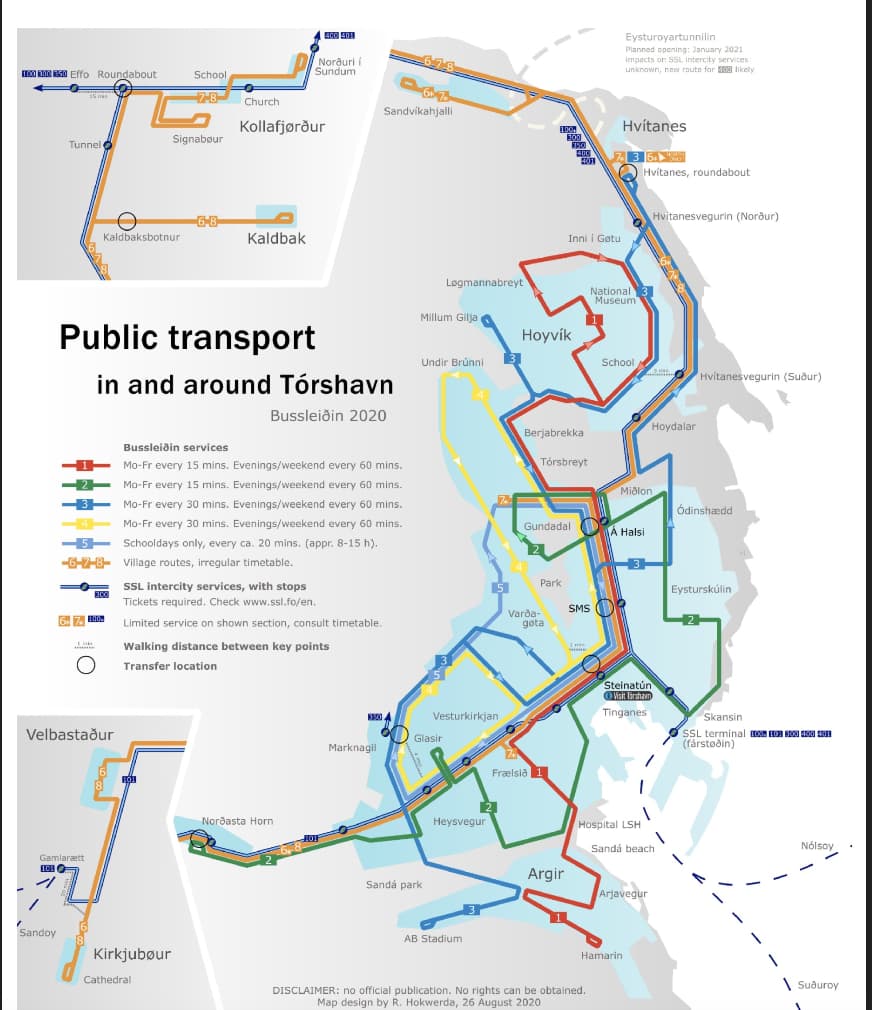
|
|
|
|
SOR bus from the 2011 fleet renewal on Line 1 leaving Hamarin terminus, overlooking city and harbour.
One of these SOR buses (HZ476) has been brought back to its home country
for preservation by the
Czech public transport magazine "Ceskoslovensky
Dopravak" (www.cs-dopravak.cz)
|
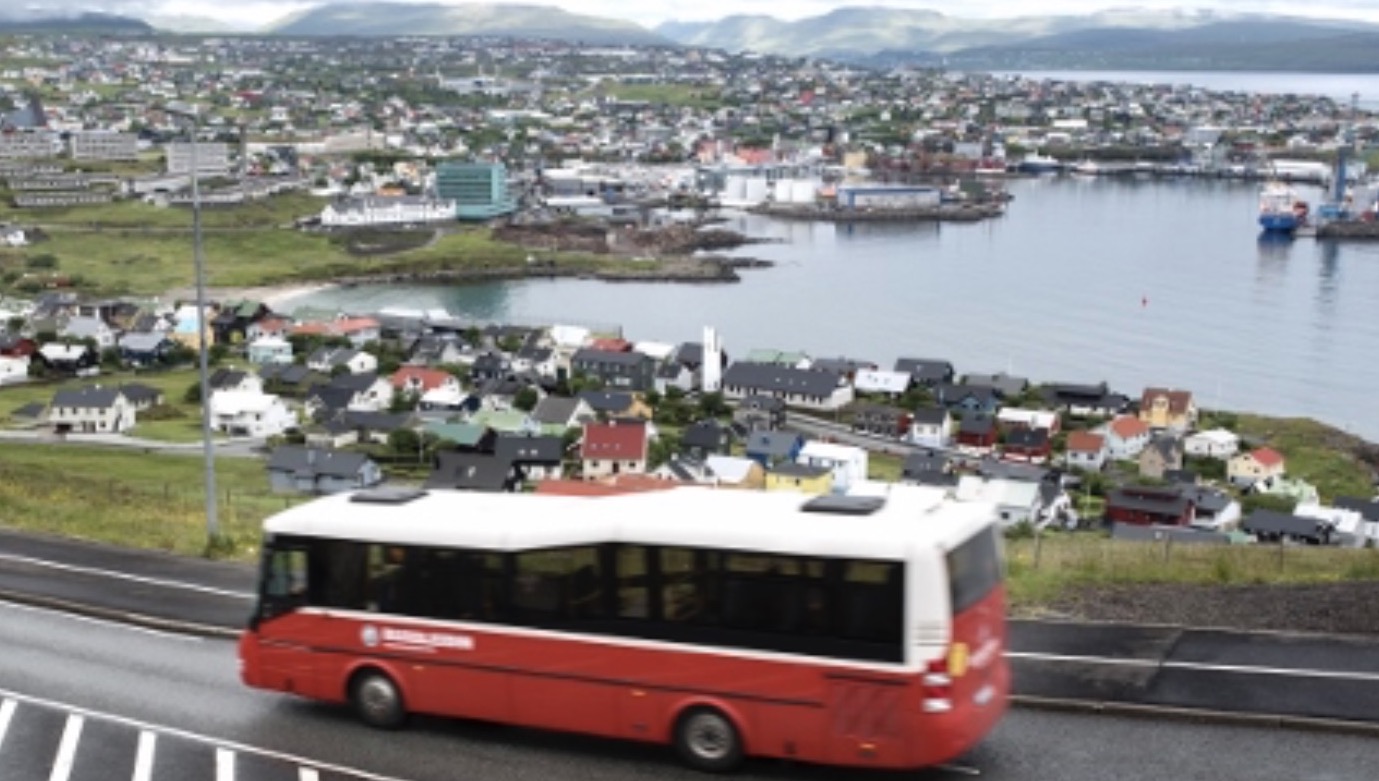 |
|
|
|
A further revision to the routes and
times was introduced on 4th July
2022.
Route 2 is
shortened and reduced to three trips an hour from four trips.
Gundadalur
is now to be served by the 4 and not the 2. Route 3 goes up to
three
trips an hour from two. Routes 4 and 5 are merged as circular route
4.
This will make it easier for residents in the HoyvÝk area
to travel directly to the cityĺs west end. Out of town routes
6 and 7 are renumbered 5 and 6, and weekend route 8 is
renumbered 7 but is reduced to Saturday only, no Sunday service.
Gundars Bussar were expected to have their operating contract renewed
from 2023 to
2031 but this did not happen. As part of a new nine year contract
starting 27 December 2022 between the
city council and HZ Bussar fifteen
new Iveco Crossway LE diesel buses have been purchased. These bear the
appropriate registrations HZ1 to HZ15 and were delivered in January
2023. As at February
2023 Volvos LR260 and GA403 as well as SORs FM854 and HZ530 were still
to be seen helping out on routes 5 and 6. A further Crossway diesel bus
HZ16 was obtained in May 2023 for the long route 6 to Kollafj°rur,
where it is based. The number of seats was increased for
passnenger comfort over the greater distance.
Tˇrshavn City Council
has pledged to convert its entire city bus fleet to electric by 2027
and in May 2023 two Heuliez GX137 electric buses came for route 4
which has the
fewest slopes. These are HZ17 and HZ18 and they went into service on 1st
June. The council will be in regular consultation with the
operator about how
to reach the zero-emission city bus objective by 2027.
In June 2024 the City Council resolved that the bus routes should run
longer, especially in the evenings and at weekends. Extra
journeys were added to routes 2 and 3 whilst route 1 had its evening
and weekend frequency increased from hourly to half hourly, using two
buses instead of one. This is the busiest route passing the National
Hospital, schools, churches, meeting houses and sports grounds.
|
Iveco Crossway buses for Torshavn delivered January 2023
Travel on the city buses has been free since January 2007
|
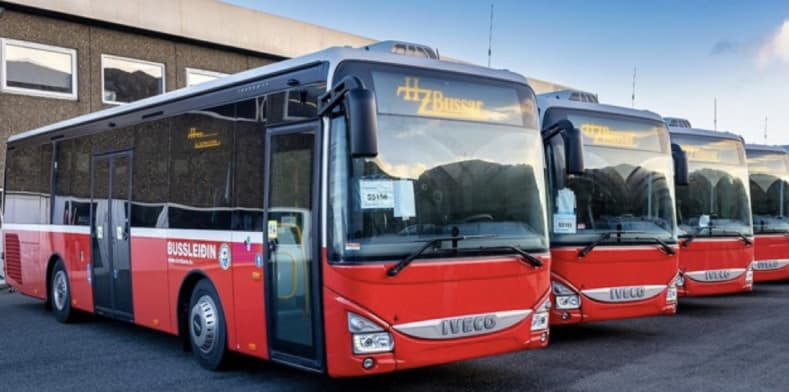
|
With many thanks to Bil of Tˇrshavn for the use
of their
pictures of days gone by
and to Renno Hokwerda and John Veerkamp for current information.
Renno made the 2020 map in English above of the Torshavn city routes.
|
Bussleiin
er ein třdningarmikil bindiliur millum h°vusstain og bygdirnar Ý
Tˇrshavnar kommunu. Sjey bussleiir r°kja samfersluna Ý kommununi.
Bussarnir eru bŠi lŠttir og umhv°rvisvinarligir, og allar sjey leiir
eru ˇkeypis at br˙ka.
|
|
|
|
|
|
|
|
|
|













